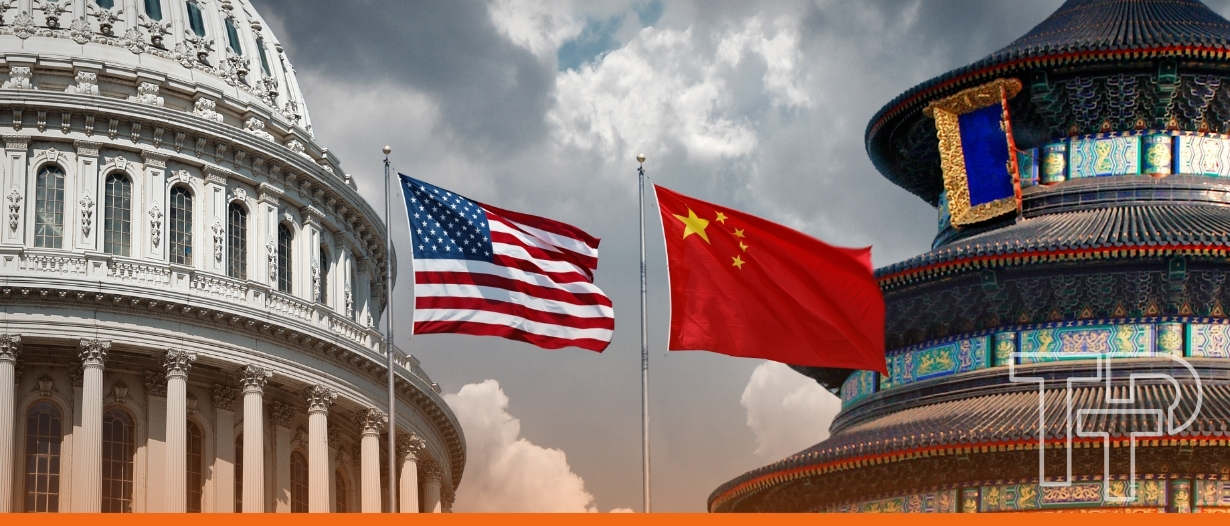Treasury and payments: Rethinking transaction fees in the era of instant everything
Alan Koenigsberg
Apr 27, 2025
 Carter Hoffman
Apr 25, 2025
Carter Hoffman
Apr 25, 2025

After years of simmering trade tensions, the United States-China trade policy entered a new and tumultuous phase in 2025.
The US has veered from its decades-long free-trade stance toward an aggressive, reciprocity-driven approach, with tariffs on imports (especially those originating in China) skyrocketing to levels not seen in a century.
This sea change in policy is upending World Trade Organization (WTO) norms, prompting Chinese retaliation, and forcing businesses worldwide to rethink supply chains.
On Thursday, Trade Policy Research Forum (TPRF) held an expert webinar featuring Henry Gao, Professor of Law at Singapore Management University, and Haun Zhu, Vice-President of China Trade Monitor, exploring the shifts in the US-China trade dynamic and what it means for the rest of the world.
On 2 April 2025, dubbed “Liberation Day”, the US announced the most sweeping tariff increases since the 1930 Smoot–Hawley Act. This included a universal 10% tariff on all imported goods (effective April 5) and planned additional “reciprocal tariffs” ranging from 11% up to 50% on imports from 57 specific countries (to start April 9).
According to Professor Gao, the rationale for these dramatic measures is both ideological and transactional. Publicly, the US administration framed them as a long-overdue corrective to decades of asymmetrical foreign tariffs and other barriers that boxed out US goods. At the same time, a quieter motive is simply fiscal, as the tariffs can function as a revenue-raising tool for Washington. Analysts note that the new import taxes could generate hundreds of billions in revenue, eyed to help fund domestic programs (like proposed tax cuts) without increasing debt.
The emphasis on “reciprocal” deals also signals a US preference for bilateralism over multilateralism. Rather than broad WTO-led liberalisation, Washington is seeking one-on-one trade arrangements where it can demand symmetry. In practice, this has meant pressuring partners to lower their tariffs to US levels or face raised duties.
For example, soon after the Liberation Day announcement, many US allies scrambled to negotiate exemptions or new agreements to avoid being hit by the country-specific tariffs.
Professor Gao described this US strategy of wielding tariffs as leverage for concessions as a fundamental realignment of trade policy, from pursuing open markets to “leveraged” or conditional market access. It’s a high-stakes gamble that risks fragmenting the global trading system, as explored below.
The US’s new approach is testing the foundations of the WTO, particularly the core principles of Most-Favoured-Nation (MFN) and national treatment that underpin non-discrimination in trade.
Under WTO rules, members are generally expected to apply the same tariff rates to all trading partners (MFN), barring free-trade agreements or special exceptions.
Not surprisingly, China has legally challenged the US measures at the WTO, arguing they violate MFN obligations. In February, Beijing filed a formal WTO dispute, alleging that the US is failing to provide equal tariff treatment to all members as required.
Chinese officials contend that Washington’s “excessively high tariffs” amount to “unilateral bullying” in breach of international rules. Other countries have echoed concerns that the US actions undermine the predictability of the multilateral trading system.
Smaller countries, in particular, worry about being caught in a lawless trade jungle. African WTO members, for instance, rarely have the clout to challenge trade superpowers and thus rely on a rules-based system to counteract power asymmetries.
If the WTO’s authority continues to be undermined by its largest members, those smaller economies will be left most vulnerable.
Beijing has responded to Washington’s pressure with a mix of retaliatory tariffs, formal complaints, and efforts to build new trade bridges. China’s immediate reaction to Liberation Day was tit-for-tat tariff escalation. It raised its import duties on US goods to 125%, matching (and slightly undershooting) the enormous US tariff hike on Chinese goods (which reached 135–145% on average for Chinese exports).
Such astronomical tariff levels have essentially shut down normal bilateral goods trade. Analysts note that anything above around 35% duty typically wipes out a product’s profit margin.
Chinese officials have been openly critical in their rhetoric. The Finance Ministry in Beijing blasted the US moves as violating international rules and “running counter to basic economic principles and common sense”.
Beyond tariffs and lawsuits, China is deploying other levers of statecraft in response. It has doubled down on a “divide-and-conquer” diplomatic strategy to build alliances and reduce its isolation. President Xi Jinping and his government have been courting other trading partners aggressively in the wake of the US rift.
Xi has publicly called on the EU to join China in opposing US unilateralism, telling visiting European leaders that China and Europe should “jointly oppose unilateral acts of bullying”. In April, Xi embarked on a high-profile tour of Southeast Asia (visiting Vietnam, Malaysia, Cambodia) to consolidate ties with close neighbours amid the tariff war. The aim is to reassure Asian partners that China will support them economically, and perhaps to dissuade them from siding with Washington.
Amid this external turbulence, a key question is how China’s own economic model is adapting (or failing to adapt) to the new reality. The trade war is putting pressure on Beijing to accelerate internal reforms that have long been discussed.
For years, economists have urged China to rebalance its economy toward domestic consumption. Consumption (household and government combined) makes up only about 53–54% of China’s GDP, far below the roughly 75% typical in advanced economies. Investment (much of it state-driven) constitutes an unusually high share of GDP. This imbalance means China has depended on external demand (i.e., exports) and debt-fuelled infrastructure spending to drive growth. Now, with exports to its biggest customer (the US) under threat, the urgency to spur Chinese consumer spending is greater than ever.
In tandem with raising consumption, market liberalisation and reform of inefficient sectors is another area of needed change. Here too, progress is mixed at best. On the one hand, China has gradually opened some industries. On the other, under President Xi, the general trend has been toward a more state-controlled economy, not less.
Foreign investors have certainly noticed. Foreign direct investment (FDI) into China plummeted in 2023, dropping 8% year-on-year, the first decline in a decade. Western firms cite an unpredictable regulatory environment and growing political risks as reasons to think twice. Indeed, Xi’s focus on national security and self-reliance has left many foreign companies uncertain about where they might step over the line of the law.
Lacking robust FDI and facing external decoupling, China may have no choice but to lean more on domestic investment (likely government-led) to prop up growth in the short term. The long-term solution, however, many experts argue, is for China to undertake the kind of difficult reforms it has so far avoided: strengthen the social safety net (so households feel secure enough to spend savings), allow more private competition in sectors dominated by state monopolies, and enforce hard budget constraints on local governments and state owned enterprises to curb wasteful over-investment.
In the context of the trade war, political will for reform within China will determine whether the country can weather the storm by unlocking new internal sources of growth or whether it doubles down on its existing model and hopes for an external truce. So far, the signals are mixed. Beijing’s rhetoric acknowledges the need for a new growth path, yet concrete action has been cautious.
—
As Henry Gao and Huan Zhu conveyed in the TPRF webinar, China, which rose to economic prominence within the US-led open trade framework, now finds that framework fraying as it comes under direct attack from Washington’s tariffs and technology controls.
Supply chains are diversifying by necessity, and trade compliance is becoming as strategically important as production costs. Companies with interests in both the US and China must prepare for a prolonged period of tension, where tariffs and export controls can change with little notice and political factors trump economic logic.
Finally, much will depend on domestic developments within the US and China. In Washington, how durable is the consensus for hardline trade measures? In Beijing, will economic stress force a moderation of state intervention and a pivot to market reforms, or will it reinforce the current statist approach? The answers to these questions will shape whether the present conflict escalates, stabilises, or perhaps even gives way eventually to a new equilibrium.
The era of complacency in US-China trade is over, and a new, more complex chapter has begun.

Alan Koenigsberg
Apr 27, 2025

Carter Hoffman
Apr 25, 2025
Trade Treasury Payments is the trading name of Trade & Transaction Finance Media Services Ltd (company number: 16228111), incorporated in England and Wales, at 34-35 Clarges St, London W1J 7EJ. TTP is registered as a Data Controller under the ICO: ZB882947. VAT Number: 485 4500 78.
© 2025 Trade Treasury Payments. All Rights Reserved.